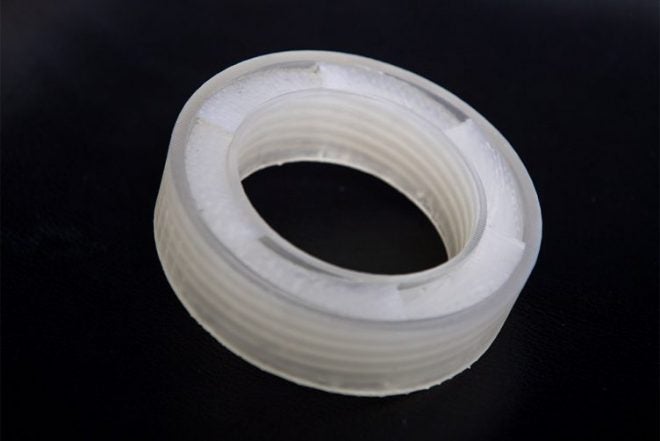Recent research from the Department of Mechanical Engineering of Boston University made headlines in several non-specialized blogs and media, thanks to its potential. Boston Engineers managed to design and manufacture a noise canceling barrier which allows airflow to pass through.
The team of Engineers set forth on developing a sound barrier that could, for example, be put on the exhaust of a jet engine, reducing its noise without affecting its thrust.
The concept, together with the “donut” shape adopted for the prototype, automatically takes the thought to firearm suppressors.

3D printed acoustic metamaterial sound barrier. Photo from Boston University.
Let’s have a very quick look at what acoustic metamaterials are, first.
Acoustic Metamaterials
Are these actually specific materials? The short answer is No.
Wikipedia provides the following brief introduction to metamaterials:
A metamaterial (from the Greek word μετά meta, meaning “beyond”) is a material engineered to have a property that is not found in naturally occurring materials. They are made from assemblies of multiple elements fashioned from composite materials such as metals or plastics. The materials are usually arranged in repeating patterns, at scales that are smaller than the wavelengths of the phenomena they influence. Metamaterials derive their properties not from the properties of the base materials, but from their newly designed structures.
Different categories of metamaterials exist, depending on the type of phenomena they are designed to influence. For example, those designed to control electromagnetic radiations, such as visible light, could, in theory, allow the creation of an invisibility cloak.
Acoustic metamaterials are therefore structures engineered in such a way that allows them to control specific properties of sound.
Regarding the actual manufacturing of these structures, anyone who is familiar with 3D printing knows that lattice architectures are usually associated with these processes. It’s therefore easy to realize that these metamaterials can benefit enormously from the design freedom unlocked by additive manufacturing.
Boston University Experiment
Below the video of the actual experiment which is claimed to have offered a sound reduction of 94%:
The sound barrier in the video allows air passage through its central opening, but it is engineered in a way that it sends sound back to its source instead of radiating it forward.
While the results are impressive, the experimental conditions, from temperature, to sound source and materials, are substantially different from the ones associated with a firearm suppressor. But so are the ones with a jet exhaust, which is one of the noise sources used as an example of potential development by the Boston Engineers.
The primary result of the Team is having a mathematical framework which allows them to “design an object that can block the sounds of anything”.
Implications for Suppressors
Would such engineered “barrier” work as a silencer by itself? Most likely not.
Would it be a good replacement for currently designed baffles? Probably not.
Current suppressors are designed to allow expansion of hot gasses which results in a reduction of sound signature.
The current design approach to suppressors is therefore rooted in fluid dynamics. Since the above metamaterial is designed to allow full airflow it would likely have a limited effect on the expanding gasses.
It is, however, the author’s belief and hopes that a metal acoustic metamaterial could be designed to act as an end cap of a relatively traditional suppressor. This end cap would be designed to target specific frequencies augmenting the overall sound pressure reduction of the silencer.
Also, it would be one use of additive manufacturing applied to muzzle devices showing the real potential of the technology: to offer performance improvement in ways not achievable with conventional processes.
What do you guys think?
Real opportunity to read about on a Saturday, or “pipe dream”?
Source: Boston University
 Your Privacy Choices
Your Privacy Choices